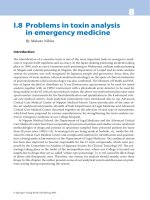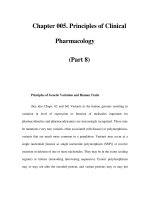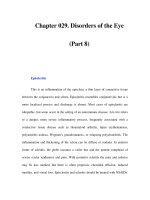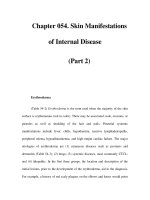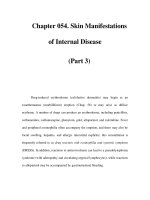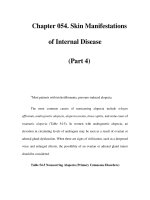Chapter 114. Molecular Mechanisms of Microbial Pathogenesis (Part 8) pdf
Bạn đang xem bản rút gọn của tài liệu. Xem và tải ngay bản đầy đủ của tài liệu tại đây (50.34 KB, 5 trang )
Chapter 114. Molecular Mechanisms
of Microbial Pathogenesis
(Part 8)
GPI-anchored receptors do not have intracellular signaling domains.
Instead, the mammalian Toll-like receptors (TLRs) transduce signals for cellular
activation due to LPS binding. It has recently been shown that binding of
microbial factors to TLRs to activate signal transduction occurs not on the cell
surface, but rather in the phagosome of cells that have internalized the microbe.
This interaction is probably due to the release of the microbial surface factor from
the cell in the environment of the phagosome, where the liberated factor can bind
to its cognate TLRs. TLRs initiate cellular activation through a series of signal-
transducing molecules (Fig. 114-3) that lead to nuclear translocation of the
transcription factor nuclear factor κB (NF-κB), a master-switch for production of
important inflammatory cytokines such as tumor necrosis factor α (TNF-α) and
interleukin (IL) 1.
Inflammation can be initiated not only with LPS and peptidoglycan but also
with viral particles and other microbial products such as polysaccharides,
enzymes, and toxins. Bacterial flagella activate inflammation by binding of a
conserved sequence to TLR5. Some pathogens, including Campylobacter jejuni,
Helicobacter pylori, and Bartonella bacilliformis, make flagella that lack this
sequence and thus do not bind to TLR5. The result is a lack of efficient host
response to infection. Bacteria also produce a high proportion of DNA molecules
with unmethylated CpG residues that activate inflammation through TLR9. TLR3
recognizes double-strand RNA, a pattern-recognition molecule produced by many
viruses during their replicative cycle. TLR1 and TLR6 associate with TLR2 to
promote recognition of acylated microbial proteins and peptides.
The myeloid differentiation factor 88 (MyD88) molecule is a generalized
adaptor protein that binds to the cytoplasmic domains of all known TLRs and also
to receptors that are part of the IL-1 receptor (IL-1Rc) family. Numerous studies
have shown that MyD88-mediated transduction of signals from TLRs and IL-1Rc
is critical for innate resistance to infection. Mice lacking MyD88 are more
susceptible than normal mice to infection with group B Streptococcus, Listeria
monocytogenes, and Mycobacterium tuberculosis . However, it is now appreciated
that some of the TLRs (e.g., TLR3 and TLR4) can activate signal transduction via
an MyD88-independent pathway.
Additional Interactions of Microbial Pathogens and Phagocytes
Other ways that microbial pathogens avoid destruction by phagocytes
include production of factors that are toxic to phagocytes or that interfere with the
chemotactic and ingestion function of phagocytes. Hemolysins, leukocidins, and
the like are microbial proteins that can kill phagocytes that are attempting to ingest
organisms elaborating these substances. For example, staphylococcal hemolysins
inhibit macrophage chemotaxis and kill these phagocytes. Streptolysin O made by
S. pyogenes binds to cholesterol in phagocyte membranes and initiates a process of
internal degranulation, with the release of normally granule-sequestered toxic
components into the phagocyte's cytoplasm. E. histolytica, an intestinal protozoan
that causes amebic dysentery, can disrupt phagocyte membranes after direct
contact via the release of protozoal phospholipase A and pore-forming peptides.
Microbial Survival Inside Phagocytes
Many important microbial pathogens use a variety of strategies to survive
inside phagocytes (particularly macrophages) after ingestion. Inhibition of fusion
of the phagocytic vacuole (the phagosome) containing the ingested microbe with
the lysosomal granules containing antimicrobial substances (the lysosome) allows
M. tuberculosis , S. enterica serovar typhi, and Toxoplasma gondii to survive
inside macrophages. Some organisms, such as L. monocytogenes, escape into the
phagocyte's cytoplasm to grow and eventually spread to other cells. Resistance to
killing within the macrophage and subsequent growth are critical to successful
infection by herpes-type viruses, measles virus, poxviruses, Salmonella, Yersinia,
Legionella, Mycobacterium, Trypanosoma, Nocardia, Histoplasma, Toxoplasma,
and Rickettsia. Salmonella spp. use a master regulatory system, in which the
PhoP/PhoQ genes control other genes, to enter and survive within cells;
intracellular survival entails structural changes in the cell envelope LPS.
Tissue Invasion and Tissue Tropism
Tissue Invasion
Most viral pathogens cause disease by growth at skin or mucosal entry
sites, but some pathogens spread from the initial site to deeper tissues. Virus can
spread via the nerves (rabies virus) or plasma (picornaviruses) or within migratory
blood cells (poliovirus, Epstein-Barr virus, and many others). Specific viral genes
determine where and how individual viral strains can spread.
Bacteria may invade deeper layers of mucosal tissue via intracellular uptake
by epithelial cells, traversal of epithelial cell junctions, or penetration through
denuded epithelial surfaces. Among virulent Shigella strains and invasive E. coli,
outer-membrane proteins are critical to epithelial cell invasion and bacterial
multiplication. Neisseria and Haemophilus spp. penetrate mucosal cells by poorly
understood mechanisms before dissemination into the bloodstream. Staphylococci
and streptococci elaborate a variety of extracellular enzymes, such as
hyaluronidase, lipases, nucleases, and hemolysins, that are probably important in
breaking down cellular and matrix structures and allowing the bacteria access to
deeper tissues and blood. Organisms that colonize the gastrointestinal tract can
often translocate through the mucosa into the blood and, under circumstances in
which host defenses are inadequate, cause bacteremia. Y. enterocolitica can invade
the mucosa through the activity of the invasin protein. Some bacteria (e.g.,
Brucella) can be carried from a mucosal site to a distant site by phagocytic cells
(e.g., PMNs) that ingest but fail to kill the bacteria.
